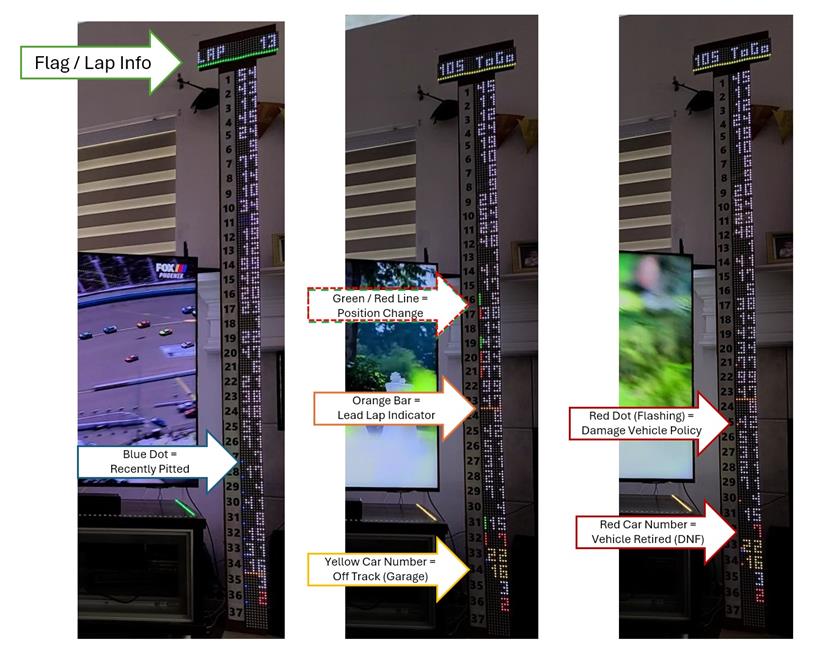By Seth Eggert, Associate Editor
After the historic three-wide NASCAR Cup Series photo finish at Atlanta Motor Speedway, one fan, Leuel Asnake, tweeted a video of the reaction of him, and his friends who had never watched the sport before. Besides the reactions to the close finish, an eight-foot-tall custom scoring pylon next to Asnake’s TV quickly grabbed the attention of NASCAR fans.
Asnake’s Custom Scoring Pylon
With over 2,000 LED bulbs, the custom scoring pylon uses live data that’s available through NASCAR’s public live leaderboard to show where each driver is running and their on-track status. Different color coding allows fans to see who is on track, on the lead lap, on pit road, in the garage, the current free pass driver, if a driver is on the Damaged Vehicle Policy, or out of the race.
Being a software developer by trade, he wanted a way to enhance his experience watching races when at home. That allowed the avid fan to combine his different passions, motorsports and technology, to create his own personal scoring pylon.
“I decided to build a scoring pylon because this project combined my two biggest passions – racing and technology!” Asnake explained. “In my day job, I’m a software engineer and enjoy the problem-solving challenges accompanied with developing code to design useful applications. Furthermore, I wanted to enhance my race watching experience by being able to glance and see the race conditions (lap count / flag) and running positions at a glance, even when TV was in a commercial break!”

The Pylon’s Origins
The custom scoring pylon project started for the Texas A&M University alum in 2020. Asnake hosted watch parties in his apartment while a student at the university. It was during that time that the fan, who already had a following on YouTube in the NASCAR and iRacing communities, came up with the idea of adding RGB LED lighting that was synced with the racing action.
By the 2020 edition of NASCAR Speedweeks at Daytona Int’l Speedway, Asnake had functioning lights around his TV. Upon graduating in May 2020, he had decided to upgrade and improve the lights since he had to rebuild the system after moving out. It was at that time that he first added lights to note the Stage breaks.
“(A) few years later around mid-season 2022, I noticed I was not using the position data in the public leaderboard,” Asnake explained. “I had the pylon idea for a while, but it took some time to build it practically and efficiently. (Wiring all the LEDs manually, for example, would not be a viable solution). Eventually I found matrix panels that solved my problem and got to programming and building.
“Initially, only the positions were displayed, but as I kept using the product week to week, I kept thinking of ideas and adding features that show advanced information that I, as a race fan, would like to see. Right now, as my video demo showed, the pylon shows lead lap bar, position changes, driver pit, damage, and overall status color coded. The product is continually evolving, and as I think of more ideas, I am continually updating the software to add features and enhancements.”
The Challenges Faced
Like any entrepreneur in the early or mid-stage development of an idea or product, Asnake faced several challenges. From syncing the custom scoring pylon to his TV and the TV broadcast to developing different hardware and software to allow the pylon to work as intended. In addition to that, he needed to manage the amount of power that nearly 2,200 LED light bulbs was drawing and the limited memory capacity of the system.
“The biggest challenge with my system is synchronizing the timing and scoring data with the live TV broadcast,” Asnake stated. “The data feeds from NASCAR update about once every 30 seconds and are usually ahead of my TV feed. Therefore, I have a delay mechanism in my software that I can adjust on the fly to match up closely with TV. This allows my display to be accurate within a half a lap at most tracks and within 1.5 or so laps at the shortest tracks.
“Other challenges are typical with developing hardware and software such as managing the power draw of the 2,198 individually addressable LEDs that make the pixels on the tower and TV stand and managing the limited memory capacity and networking capabilities of the microcontroller (CPU) that runs the whole system.”
Humbling Attention and Mass Production?
Recently Asnake posted a video on social media that details how the custom scoring pylon works. Responses quickly poured in from NASCAR Hall of Famer Dale Earnhardt Jr. expressing his desire to own one as well as others from inside the industry and fans themselves.
Further exposure on Asnake’s custom scoring pylon was drawn from NASCAR on NBC’s social media account sharing the explanation video. The video even transcended NASCAR community, being viewed by industry members in Formula 1, IndyCar, and IMSA.
“(The feedback) has been extremely humbling!” Asnake said “From Dale Jr. himself re-tweeting and expressing a desire to own one, to the many handful of industry members and fans that have commented and reached out to me, the response has greatly exceeded my expectations!
“As someone who has been a passionate fan of this sport for over 15 years, it is a dream to be in such a position. Whether it’s for a race team, track, or NASCAR itself, this project has opened doors to a handful of opportunities I look forward to exploring!”
As for how long someone like Earnhardt could own their own person scoring pylon, the timetable is still not known. Asnake is currently researching both hardware and mass production solutions to make it possible. At the same time, he is also continually updating and adding to the unique home viewing experience that he has created.